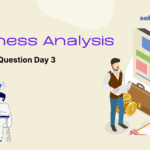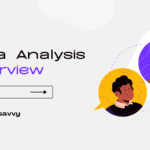Welcome to Day 3 of our comprehensive guide to mastering data analyst interviews! Today, we’ll focus on behavioral interview strategies, navigating the final stages of the interview process, and diving into real-world case studies. Let’s equip you with the skills and knowledge needed to shine in your upcoming interviews.
Question: Tell me about a challenging data analysis project you worked on. How did you approach it, and what was the outcome?
Answer: In a previous project, I was tasked with analyzing customer feedback data to improve product satisfaction. I started by collecting and cleaning the data, then conducted sentiment analysis to categorize customer comments. By identifying common themes and pain points, I was able to provide actionable recommendations to the product team, leading to a measurable increase in customer satisfaction scores.
Question: Describe a time when you had to communicate technical findings to non-technical stakeholders. How did you ensure they understood the insights?
Answer: In one instance, I presented the results of a predictive modeling project to senior management who had limited technical knowledge. To make the findings accessible, I used clear visualizations and avoided technical jargon. I also provided real-world examples and practical implications of the analysis, ensuring that stakeholders could grasp the key takeaways and make informed decisions.
Question: How do you prioritize competing tasks and deadlines in a fast-paced environment?
Answer: I prioritize tasks based on their urgency, impact, and dependencies. I create a prioritized to-do list and regularly reassess priorities as new tasks arise. Effective communication with stakeholders is key, as it helps manage expectations and ensure alignment on deadlines and deliverables.
Question: Describe a time when you faced resistance or scepticism about your data analysis findings. How did you address it?
Answer: In a project where my analysis challenged existing beliefs, I proactively engaged stakeholders in discussions to understand their concerns. I provided additional context and evidence to support my findings, highlighting the rigor of the analysis and its potential impact on decision-making. By fostering open dialogue and addressing concerns transparently, I was able to gain buy-in and support for the recommendations.
Question: Can you discuss a situation where you had to adapt to unexpected changes or obstacles during a data analysis project?
Answer: During a project where data quality issues emerged unexpectedly, I quickly adjusted my approach by collaborating with the data engineering team to resolve the issues. I revised my analysis plan and communicated any delays or changes to stakeholders proactively, ensuring transparency and maintaining project momentum.
Question: How do you stay updated on the latest trends and developments in the field of data analysis?
Answer: I stay updated through a combination of reading industry publications, attending conferences and webinars, and participating in online forums and communities. I also engage in continuous learning through online courses and certifications to expand my skill set and stay abreast of emerging technologies and methodologies.
Question: Describe a situation where you had to work collaboratively with cross-functional teams to achieve a common goal?
Answer: In a project where I collaborated with the marketing and sales teams to analyze customer segmentation data, I facilitated regular meetings to align on project objectives and share progress updates. By leveraging each team’s domain expertise and insights, we developed targeted marketing campaigns that resulted in a significant increase in customer engagement and sales.
Question: How do you handle feedback and criticism on your work?
Answer: I view feedback as an opportunity for growth and improvement. I actively seek feedback from peers and stakeholders throughout the project lifecycle and remain open to constructive criticism. I reflect on the feedback received, identify areas for improvement, and incorporate lessons learned into future projects.
Question: Can you discuss a time when you had to make a decision based on incomplete or ambiguous data?
Answer: In a project where data was limited or uncertain, I adopted a hypothesis-driven approach and conducted sensitivity analyses to assess the potential impact of different scenarios. I communicated the uncertainties transparently to stakeholders and recommended risk mitigation strategies to account for the limitations of the data.
Use Case Questions:
Question: You’re tasked with analyzing user engagement data for a mobile app. How would you identify factors influencing user retention and recommend strategies to improve it?
Answer: To identify factors influencing user retention, I would analyze user behavior metrics such as app usage frequency, session duration, and feature engagement. Using cohort analysis, I would track user retention rates over time and identify patterns among different user segments. Based on insights gained, I would recommend strategies such as optimizing user onboarding experiences, implementing personalized notifications, and enhancing app features to improve user engagement and retention.
Question: Imagine you’re analyzing supply chain data for a manufacturing company. How would you identify inefficiencies in the supply chain and propose solutions to optimize it?
Answer: To identify inefficiencies in the supply chain, I would analyze key performance indicators such as lead times, inventory turnover, and order fulfillment rates. I would also conduct root cause analysis to identify bottlenecks and areas of waste or redundancy. Based on the analysis, I would recommend solutions such as process optimization, vendor consolidation, inventory management improvements, and supply chain automation to streamline operations and reduce costs.










